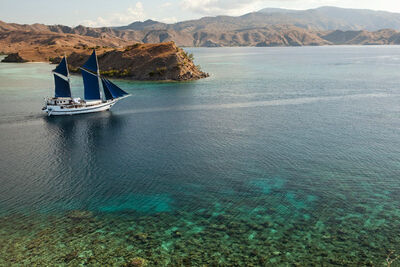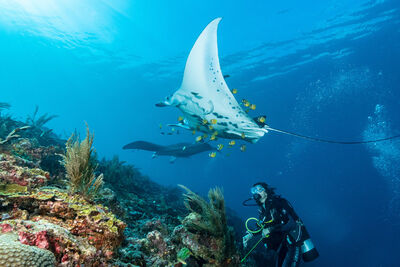Early in the 16th century, the Portuguese arrived in the Malay Archipelago and took control of the island of Flores, among others. The name Flores means 'Flowers' in Portuguese, and after a spell of Portuguese rule in the mid-19th century, the island became part of the Dutch East Indies. Flores (which also lent its name to the Flores Sea) was an important stop in the spice trade, with cloves, mace and nutmeg from the Spice Islands (the Maluku Islands) heading west towards European kitchens. Today, the Flores Sea is still an important shipping lane, but is perhaps better known for its rich biodiversity, both beneath its waves and along its shores. Keen to learn more about this watery world? Let's dive in to take a closer look and see what spicy Flores Sea facts we can discover...
1. The Flores Sea covers over 92,000 square miles
Sitting pretty much slap-bang in the middle of the myriad Indonesian islands, the Flores Sea covers an area of over 92,000 square miles. Its southern border includes the northern coast of Flores and most of Sumbawa's northern boundary. To the north sits the island of Sulawesi - also known as Celebes - and the Makassar Strait. At either end, the Flores Sea meets other bodies of water: the Java and Bali Seas to the west and the Banda Sea to the east.
The Flores Sea encompasses several islands. As well as Flores, Sulawesi and Sumbawa at its boundaries, the islands of Rinca, Komodo, Moyo and the Selayar Islands are all lapped by waves from the Flores Sea.

2. The Flores Sea is the traditional home of pinisi boats
The Flores Sea is home to three of Indonesia's famed seafaring communities: the Bugis, Makassarese, and Bajau peoples. Historically, these groups were responsible for perfecting the traditional pinisi boats, which they used to transport spices, timber, rice and textiles between the region's many islands.
Pinisi boats are characterised more by the style of sails than by the size and shape of the hull. But what makes them special? The sails were drawn out over horizontal bars extending from the masts, rather than raised up the masts as was typical in traditional Western shipping at the time. Impressively, pinisi boats were the largest in the region, yet were built without big shipyards. The know-how and knowledge required have been passed down from generation to generation, and the method was recently recognised by UNESCO and placed on its Lists of Intangible Cultural Heritage. Pretty cool stuff.
3. The Flores Sea sits within the Coral Triangle
The Coral Triangle, which covers parts of Indonesia, Papua New Guinea, the Philippines, the Solomon Islands, and Timor-Leste, is renowned as the global centre of marine biodiversity. While it covers just over one and a half per cent of Earth's total oceanic area, the Coral Triangle contains (deep breath) over three-quarters of the world's reef-building coral species, 37% of the world's reef fishes and six out of seven of the world's turtle species.
The Coral Triangle also contains some of the world's most celebrated diving destinations - including Raja Ampat and Tubbataha - with the Flores Sea section including perennial favourites such as Komodo, Moyo Island and, where the Flores Sea and Banda Sea meet, Wakatobi.

4. The Flores Sea is a deep-sea biodiversity hotspot
The Flores Sea reaches a maximum depth of 5,140 metres in an area called the Flores Basin. Hot on its heels is another deep trough, close to Sulawesi and farther north, which reaches a depth of 3,370 metres. While the shallower portions are blessed with bountiful corals and marine life, these deeper sections are also biodiversity hotspots.
Deep-sea researchers have encountered many weird and wonderful creatures, from bioluminescent jellyfish to giant squid, and new species are often spotted on submersible dives to survey the seabed. Large cetaceans swim in the open sea above these deep abysses as they move between the Pacific Ocean and the Indian Ocean; orcas, blue whales, sperm whales, dolphins and oceanic sunfish have been spotted cruising the Flores Sea.

5. Dragons swim in the Flores Sea
In the early days of maritime exploration, hic sunt dracones was a Latin phrase found scrawled on maps across uncharted areas of the ocean, meaning 'here be dragons'. Today, thanks to much more extensive ocean exploration, that phrase is no longer used by cartographers. But there's a corner of the Flores Sea where you may well spot dragons having a cooling swim (yes, really).
Nestled between Sumbawa and Flores are the islands of Rinca and Komodo, home to the largest extant lizard species - the Komodo dragon. These giant carnivorous lizards are land-based, where they feast largely on local deer and wild pigs, but they're also known to take a refreshing dip in the Flores Sea from time to time.
6. The Flores Sea is home to world-class diving
Komodo National Park features highly on many divers' bucket lists. And for very good reason. The park's islands are fringed with stunning coral reefs that attract a superb array of marine life, both big and small. Reef sharks, whale sharks, manta rays, Napoleon wrasse, Halimeda ghost pipefish, nudis, frogfish and pygmy seahorses are all regularly spotted enjoying the nutrient-rich currents. Komodo is ideal for cruising on board a pinisi-style liveaboard, such as the Alila Purnama.
Our top tip? For a more relaxing, land-based dive trip, head halfway between Bali and Komodo to Moyo Island. The lush island is less visited than Komodo, but its diving is still very special. Mantas, whale sharks, turtles and sailfish, as well as many smaller, more colourful fishes, inhabit the island's dive sites. With plenty to see and fewer divers in the water, Moyo Island is a more tranquil way to explore the world-class diving in the Flores Sea.
















